8 times nature was totally metal in 2020
Remembering the cannibal dinosaurs, chest-bursting eels, and rampaging galaxies that made 2020 heavier than dark matter.
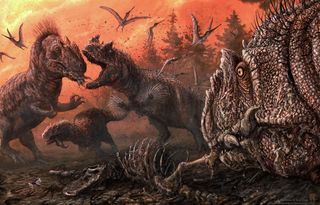
This year, a lively debate raged in the scientific community: Just how metal (see: epic, awesome, brutal) was nature in 2020?
Following yet another year of record wildfires, hurricanes and high temperatures, climate scientists determined that 2020 was in fact the most metal year on record since record-keeping began. But paleontologists countered, saying that nature was actually way more metal 200 million years ago, while astronomers argued that the most metal stuff in the universe happened billions of years ago, and we're only now just seeing it.
Who is right? You be the judge. Here are eight of the most metal things nature threw at us in 2020. (For the record, nature was also totally metal in 2018 and 2019.)
Volcano lightning
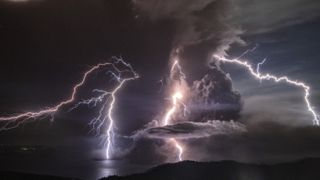
Some volcanoes are so metal that an eruption of lethal ash and lava isn't enough for them: Like Zeus himself, they insist on throwing in some thunderbolts, too.
Volcano lightning isn't particularly rare, but in January 2020 we saw a dazzling example of the phenomenon when the Taal volcano, located about 40 miles (65 kilometers) south of the Philippines capital, Manila, began blasting ash and smoke 9 miles (14 km) into the air. Inside the monolithic ash column, particles collided and produced enough static electricity to send lightning bolts scattering across the sky. Whether or not such a column could power an electric guitar is a question unanswered by science.
An eel goes 'Alien'
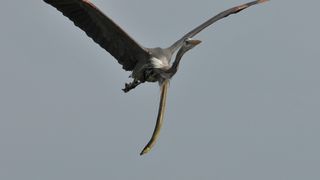
An American eel was not prepared to greet the reaper when a hungry heron swooped down and attempted to gobble him up. Photographers caught the eel bursting out of the heron's stomach mid-flight, dangling down like a big green necktie.
Gross? Absolutely. Unusual? Again, the answer is yes. While certain species of eels are known to burrow out of a fish's stomach after being swallowed, this is the first recorded incident of a live eel chewing through a bird's belly. Remarkably, it's possible that both creatures survived the encounter, researchers told Live Science.
Other herons reviewing this photo commented: “Nope. Nope. Nope nope nope nope nope nope…”
Attack of the Kraken
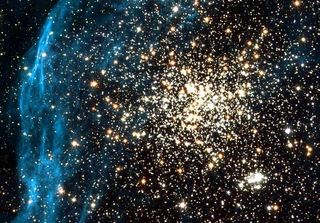
One of the most epic things ever to happen to the Milky Way went down more than 10 billion years ago, when a monster galaxy named the Kraken crashed head-on into ours. The Milky Way was young at the time and about four times less massive than it is today, scientists found in an October 2020 study, which means that merger likely reshaped our galaxy more than any other galactic collision in history, the team wrote.
Scientists learned of the ancient collision for the first time this year while using artificial intelligence (AI) to study tight-knit groups of stars called globular clusters. Clusters that share the same properties (such as the ages and chemical compositions of their stars) likely entered our galaxy during the same ancient mergers. The team found evidence of five large-scale mergers — four of which we already knew about, and the fifth being the Kraken.
Two-headed snake
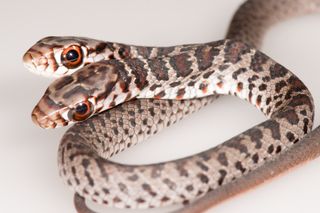
Snakes are sentient tubes of venom that can slither out of the water, the trees or the very depths of hell to ambush anything that rubs them the wrong way. (They also have orgies so rollicking that parks are forced to close). So, what's more metal than a snake? How about a DOUBLE snake?
Two-headed snakes are rare, but a Florida house cat had the dubious luck of finding one in its front yard this October. The young racer snake had two heads, two brains and two sets of fangs attached to a single body, and seemed to be holding up alright, despite some problems deciding which head got to eat first. This condition, called bicephaly, is an uncommon abnormality that occurs during embryonic development, when identical twins fail to fully separate. It occurs in all sorts of animals, including deer and porpoises.
The world's oldest squid attack

Meanwhile, paleontologists reminded us that nature (and marine life in particular) was extremely metal 200 million years ago, too. In May, researchers described a fossil showing what they believe is the world's oldest known squid attack.
The Jurassic period fossil shows a herring-like fish with its head bitten through, its bones crushed, and its body constricted by the tentacles of a 10-armed squid ancestor known as a belemnoid. Sadly for the squid, disaster struck at suppertime; whatever it was, it killed both predator and prey instantly, immortalizing their final struggle in stone. (Metal).
Dino cannibals

About 50 million years later, more Jurassic creatures were up to some brutal deeds when a group of predatory Allosaurus dinosaurs started chowing down on each other's corpses. Researchers reached this conclusion while studying Allosaurus bones in Utah's Mygatt-Moore Quarry, paying close attention to any bite marks that were present.
Many bones bore the bites of theropod dinosaurs (a large group of bipedal carnivores to which Allosaurus belongs) and, in some cases, both the biter and the bitee were of the same genus. The brutal bones provide some "extremely rare" fossil evidence of dinosaur-on-dinosaur cannibalism, the researchers said – and, more importantly, were a great excuse for paleo artist Brian Engh to draw some savage dinos ripping each other's bodies to bits.
Blood snow
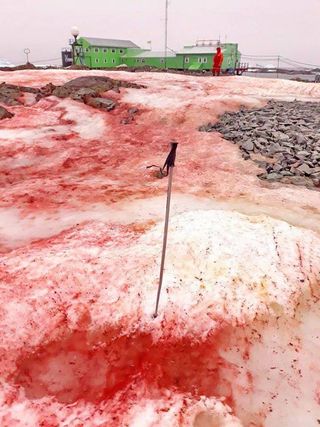
Climate change is so brutal it's making the glaciers bleed.
Well, sort of. That's not real blood in the photo above, but it is a phenomenon called "blood snow," which afflicts the world's frosty places when melting snow gives way to red-pigmented algae. Those also, called Chlamydomonas nivalis, thrive in freezing water and spend winters lying dormant in snow and ice; when summer comes and the snow melts, the algae bloom, spreading red, flower-like spores.
Ukrainian researchers at Antarctica's Vernadsky Research Base saw bucketloads of the stuff this February, around the time of the southern continent's single hottest day on record. In July, an Italian glacier also saw huge splatters of blood snow, threatening the glacier's ability to reflect sunlight and prevent melt.
The rogue Earth
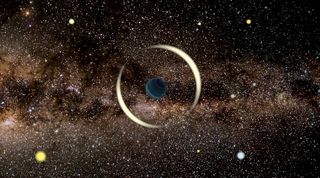
Finally, in October, astronomers detected a planet that refuses to play by the rules: a rogue, Earth-sized planet careening through the cosmos, untethered to any solar system. This is the first time a "rogue Earth" has ever been spotted in space, but it almost certainly won't be the last. According to the researchers, small rogue planets may number in the billions in the Milky Way alone, and probably outnumber the stars themselves.
Imagine: entire galaxies of unhinged rocks, flying through the darkness of the universe like wrecking balls traveling at thousands of miles an hour. Space. Is. METAL.
Originally published on Live Science
Sign up for the Live Science daily newsletter now
Get the world’s most fascinating discoveries delivered straight to your inbox.

Brandon is the space/physics editor at Live Science. His writing has appeared in The Washington Post, Reader's Digest, CBS.com, the Richard Dawkins Foundation website and other outlets. He holds a bachelor's degree in creative writing from the University of Arizona, with minors in journalism and media arts. He enjoys writing most about space, geoscience and the mysteries of the universe.
